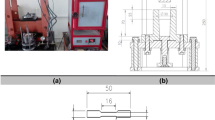Abstract
The advantages of quasi-isostatic molding in production of refractory saggers are considered. The proposed method, in which an elastic solid material acts as the molding medium, is a simplified version of isostatic molding.
Similar content being viewed by others
REFERENCES
M. I. Timokhova, Yu. N. Sil'vestrov, and Yu. G. Zorin, “Isostatic molding of ceramic articles,” Élektron. Tekhn., Ser. Materialy, Issue 3 (1972).
M. I. Timokhova and Yu. N. Sil'vestrov, “Quasi-isostatic molding of ceramic articles,” in: All-Union Scient.-Tech. Conf. “Improvement of Technologies of Electrical Engineering Porcelain” [in Russian], Moscow (1978).
M. I. Timokhova and V. S. Rachkov, “Quasi-isostatic molding in ceramic production,” in: All-Union Scient.-Tech. Conf. “Ceramics-86” [in Russian], Moscow (1986).
R. Ya. Popil'skii and Yu. G. Pivinskii, Molding of Powdered Ceramic Mixtures [in Russian], Metallurgiya, Moscow (1983).
Rights and permissions
About this article
Cite this article
Timokhova, M.I., Rachkov, V.S. Quasi-Isostatic Molding of Refractory Saggers. Glass and Ceramics 59, 98–100 (2002). https://doi.org/10.1023/A:1019523828137
Issue Date:
DOI: https://doi.org/10.1023/A:1019523828137



